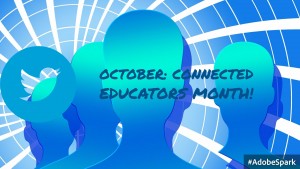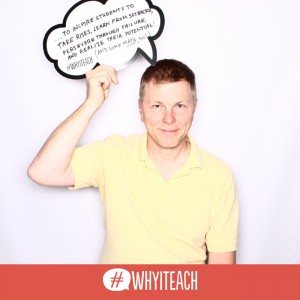The value of being a connected educator are many. First-hand experience taught me that connections could help me with lessons, ideas for activities, and resources and experts to get even more wisdom. Leveraging the ideas of many helped me realize that I am part of an extended community, and collaborating is a world-wide effort.
 Sometimes it seems like a teacher is alone in their classroom, struggling to connect with students over difficult topics. Recently, I saw a post from an AP Calculus teacher on a Facebook group that illustrated one value of being connected. “I muffed the lesson on derivatives of inverse functions”, it read, “does anyone have a great suggestion for me when I redo it?” At last count, nearly 20 other educators weighed in with activities, exercises and encouragement. Yesterday, a tweet came across my twitter feed about a blog post concerning the use of document cameras in the classroom. Intrigued, I followed the thread to the post; although the blog was from 2012, it rang true for today as well. I gained insights from someone I was not connected to, yet I felt connected through the person on Twitter whom I follow.
Sometimes it seems like a teacher is alone in their classroom, struggling to connect with students over difficult topics. Recently, I saw a post from an AP Calculus teacher on a Facebook group that illustrated one value of being connected. “I muffed the lesson on derivatives of inverse functions”, it read, “does anyone have a great suggestion for me when I redo it?” At last count, nearly 20 other educators weighed in with activities, exercises and encouragement. Yesterday, a tweet came across my twitter feed about a blog post concerning the use of document cameras in the classroom. Intrigued, I followed the thread to the post; although the blog was from 2012, it rang true for today as well. I gained insights from someone I was not connected to, yet I felt connected through the person on Twitter whom I follow.
Most of the time, when asked about being connected, teachers will talk about robust conversations on social media outlets like Twitter, Voxer, Slack, Instagram, Snapchat, Padlet, Pinterest, and many more. That is a great value, to be sure; however, developing one’s personal learning network (PLN) is the raison d’être for connected educators. Teachers can put together an idea for the classroom, and send it out via their PLNs for feedback and constructive criticism. For example, Grove City College recruited in-service teachers to connect in virtual mentoring relationships with preservice teachers for advice, feedback on course projects, and encouragement about what really happens in classrooms. Through those relationships, in-service teachers can see what is being taught in the college methods course, and the preservice teacher can see what works in an actual classroom. Further, in-service teachers share connections with college students, giving them a leg up in developing their own PLNs. If we want teachers to see being connected professionally as vital to their growth, this is a great way to accomplish it.
ISTE has a variety of PLNs with which to connect. Perhaps you already see the values of being connected – collaboration, creative ideas, constructive feedback, developing ties to the educational community – and you are using your connectivity to develop your voice. Join other communities, be they with ISTE, or any other organization to which you belong. Join in twitter chats (#isteten, for example, on October 17th) or a wide variety of others. Follow some people you know on twitter, then see who they follow. Identify thought leaders and see what they post. I have learned a lot from doing this, and I believe anyone would! When you go to conferences, ask for twitter handles or other media sign-ons. First, make sure you have your own!
Here, thanks to Jerry Blumengarten (aka @cybraryman1) is a link to a calendar of twitter chats: https://sites.google.com/site/twittereducationchats/education-chat-calendar . There’s plenty here to get started!

 ed an email from The Bill and Melinda Gates Foundation inviting me to the fifth convening of Elevating and Celebrating Effective Teaching and Teachers (ECET²). I had never heard of this, and to be honest, thought the email was either a mistake or a hoax. What, I asked myself, had I accomplished in my teaching that would make me worthy of such an invitation? I know that I have a lot of experience, but I am the kind of person and teacher that looks with awe and wonder at what others can do without giving my own work much credit. After three intense days with the ECET2 community,that is now changed!
ed an email from The Bill and Melinda Gates Foundation inviting me to the fifth convening of Elevating and Celebrating Effective Teaching and Teachers (ECET²). I had never heard of this, and to be honest, thought the email was either a mistake or a hoax. What, I asked myself, had I accomplished in my teaching that would make me worthy of such an invitation? I know that I have a lot of experience, but I am the kind of person and teacher that looks with awe and wonder at what others can do without giving my own work much credit. After three intense days with the ECET2 community,that is now changed!